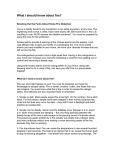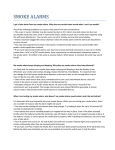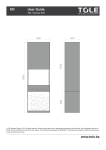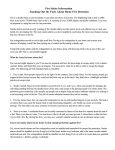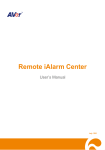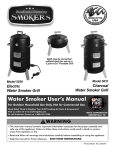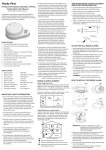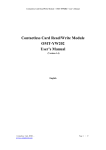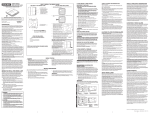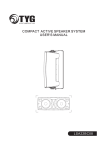Download what I should know about fire
Transcript
What I should know about fire Smoking Out the Facts About Home Fire Detection Fire is a deadly threat to any household. It can strike anywhere, at any time. The frightening truth is that in 2005, there were nearly 381,000 home fires in the U.S. resulting in over 16,000 injuries and deaths combined*. You must be prepared by using the tools for fire protection. Smoke alarms provide a warning of fire. Smoke alarms are the easiest, most cost-efficient way to alert your family of a developing fire. The more smoke alarms you have installed in your home, the more your chances increase that you will be alerted to a fire. Fire extinguishers provide a tool to fight small fires. Having a fire extinguisher in your home can increase your chances of keeping a small fire from getting out of control and becoming a deadly rage. Using both smoke alarms and fire extinguishers in your home, along with knowing what to do in case of fire, can help save your life! Fire can be a preventable tragedy! What do I need to know about fire? Fire can and might happen to you! You must be prepared and have the knowledge to escape safely. Fire is darker, smokier, hotter, and faster than you can imagine. You must know what fire is like to increase the chances of a safe escape. The following are four important facts to remember: 1. Smoke is dark. Most people expect fire to be light. For this reason, people have been trapped in their homes because they could not find their way out in the dark -- they didn't have a flashlight and didn't practice an escape plan. 2. Smoke can be deadly. Since most fire fatalities occur between 2 a.m. and 6 a.m. when most people are sleeping -- the only thing standing between the deadly fumes of fire and a safe escape maybe the piercing sound of a smoke alarm. 3. Fire has intense heat. Fire can cause the temperature to rise several hundred degrees in just seconds. The heat is so intense that it can cause the human body to stop functioning altogether - -one breath can cause severe lung damage. The heat alone can cause someone to become unconscious and not be able to escape. Escape time can be valuable. 4. Time is critical. A residential home can be totally consumed in flames in less than five minutes from the start of a fire! A home fire can double in size is just 30 seconds.* You must know what to do in order to help get you and your family out safely. A closed door is often the best way to stall a fire; by closing the door, you may save yourself seconds to use an alternate escape route. I have one smoke alarm in my home. Is that enough protection against fire? No, several smoke alarms and fire extinguishers must be installed and maintained for proper fire protection. The NFPA recommends smoke alarms be installed on every level of the home, and inside every bedroom and sleeping area. Smoke alarms should also be installed in the main corridor outside each bedroom area. Fire extinguishers should be installed on each living level, as well as in rooms that pose potential fire hazards (i.e., kitchen, garage, workshop). Installing and maintaining smoke alarms and fire extinguishers dramatically increases your family's chances of surviving a fire. Where should I install smoke alarms and fire extinguishers? Many laws require that you install at least one smoke alarm on every level of your home. It is also important to install at least one fire extinguisher in a convenient location on each level. The most basic protection for any home would be to install one smoke alarm and one fire extinguisher on each level. However, check your local building code since many require alarms also in each bedroom. Other important considerations include: 1. Mount smoke alarms in the middle of the ceiling when ceiling mounted. If that is not possible mount detectors on the wall at least three feet away from a corner and 4 - 6 inches away from the ceiling. 2. Keep smoke alarms away from drafts created by fans or air ducts. The moving air can blow smoke away from the sensor. 3. Avoid placing smoke alarms too near the kitchen stove and bathroom shower, as cooking smoke and shower steam can cause nuisance alarms. 4. Mount basement alarms at the bottom of the basement stairwell. 5. Mount fire extinguishers on a wall 3 1/2 to 5 feet above the floor. The location should be near an exit or an escape route from the room. How do I select the right smoke alarms and fire extinguishers for my home? First, establish how many you will need and where you will install each alarm and extinguisher. Once you know which rooms will have smoke alarms and fire extinguishers, you can determine which features are best suited for that area. Always choose a product which carries a standards approval symbol from a Nationally Accredited Laboratory (such as ETL or UL). This will assure you that the product has passed many stringent tests and will offer quality protection. What types of smoke alarms are there? There are two basic types of smoke alarms: ionization and photoelectric. Both are effective at detecting smoke, yet each has a unique detecting system. Ionization technology is generally more sensitive than photoelectric technology atdetecting small particles which tend to be produced in greater amounts by flaming fires, which consume combustable mateials rapidly and spread quickly. Sources of these fires may include paper buring in a wastebasket, or a grease fire in the kitchen. Photoelectric technology is generally more sensitive than ionization technologu at detecting large particles, which tend to be produced in greater amounts by smoldering fires, which may smolder for hours before bursting into flame. Sources of these fires may inculde cigarettes burning in couches or bedding. Each type of detector also comes as AC-operated smoke alarms or battery-operated smoke alarms. Some AC alarms even come with a battery back-up system. Additional options can include an escape light, silencing button, or remote control mute feature. What types of fire extinguishers are there? Fire extinguishers are categorized by ratings. These ratings determine the size and type of fire that the extinguisher can successfully put out. Fire can be divided into three categories: A, B, or C. An "A" type fire is primarily wood, paper and fabric. "B" type fires are primarily flammable liquids (such as gasoline) and oil based. Finally, "C" type fires are electrical in nature. The number preceding the A, B, or C rating determines how big of a professionally set fire the extinguisher can put out. For example, a 10-B:C extinguisher would be able to handle a 25 foot square fire of either flammable liquid or electrical origin. A 5-B:C extinguisher could handle a 12.5 square foot fire that is flammable liquid or electrical based. How do I maintain my smoke alarms and fire extinguishers once they are installed? Smoke alarms and fire extinguishers are relatively easy to maintain; yet, improper maintenance is the biggest reason smoke detectors and fire extinguishers fail. IT IS VERY IMPORTANT THAT YOU MAINTAIN ALL YOUR SMOKE ALARMS AND FIRE EXTINGUISHERS: • Test your smoke alarms weekly by pressing the test button and your fire extinguisher by checking the pressure gauge. • Replace the battery in each smoke alarm at least once a year. Better yet, when you change your clock for daylight saving time, change your battery. • Never remove the battery except when replacing it with a fresh battery. • Clean the smoke alarm at least once a year. Follow the instructions in the product's User's Manual for specific instructions on how to install and maintain your smoke alarms and fire extinguishers. Is there any other fire safety equipment that I need for my home? Having working smoke alarms and fire extinguishers in your home can greatly reduce your risk of injury or death in a fire. However, First Alert also recommends that you have flashlights in every bedroom in case of a fire emergency. Since the fire situation is very dark, a reliable working flashlight can help light your way to safety. Additionally, carbon monoxide alarms are a vital safety product necessary in any home since carbon monoxide is the leading cause of accidental poisoning death in the U.S.** An escape ladder can also be useful as a secondary escape route from a room in case one or more exits are blocked by fire or smoke. What should I do if I hear the smoke alarms sound? NEVER IGNORE THE SOUND OF A SMOKE ALARM. If the smoke alarm is sounding its alarm, there is a reason. You and your family must be able to escape quickly and safely. Here are several steps your family can learn and rehearse for an emergency: 1. Have an escape plan. Discuss and practice your escape plans. Know two exits from any room in the house. 2. Feel if the door is hot. Always feel the door to see if it is hot before opening It to escape. If the doorknob or door is hot, do not use that exit. Use your alternate exit to escape. 3. Crawl on the floor. Smoke from a fire rises and so does the temperature. If you crawl on the floor there will be less smoke and the heat from the fire will be less severe. 4. Meet at a prearranged spot outside the home. If you clearly show where everyone is supposed to meet outside the home when there is a fire, it will be easier to know who is safe. 5. Call the fire department from a neighbor's home. Be prepared to give your full name and address to the operator at the other end of the line. Stay on the line until the operator has all of the information needed. 6. Never go inside a burning building. Never return inside the house for any reason. The firefighters will be there soon. If you follow these basic fire safety tips, you will increase your family's chances for survival in a fire. Are there other ways I can protect my family from fires? The following is a fire safety checklist to lower the chances that a fire may start in your home: • Keep the furnace in working order. • Use a fireplace screen. • Have proper ventilation for heaters and other small appliances. • Do not smoke in bed. • Use the correct size fuses. • Don't use worn out electrical wiring or run it under rugs or out windows or doors. • Clear refuse away-the less clutter, the less fuel a fire has to feed on. At First Alert, your family's fire safety is our first concern. But, we can't do it alone. By properly equipping your home with smoke alarms and fire extinguishers you'll be taking an important first step in improving total fire protection for your family. If you have any other questions regarding fire safety, please contact First Alert directly. *Source: National Fire Protection Association (NFPA) **Source: Journal of the American Medical Association (JAMA)



